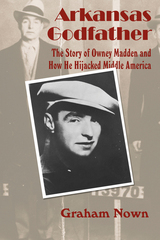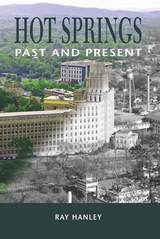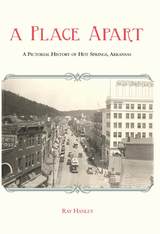4 books about Hot Springs

Arkansas Godfather
The Story of Owney Madden and How He Hijacked Middle America
Graham Nown
Butler Center for Arkansas Studies, 2013
Owney Madden lived a seemingly quiet life for decades in the resort town of Hot Springs, Arkansas, while he was actually helping some of America's most notorious gangsters rule a vast criminal empire. In 1987, Graham Nown first told Madden's story in his book The English Godfather, in which he traced Madden's boyhood in England, his immigration to New York City, and his rise to mob boss. Nown also uncovered a love story involving Madden and the daughter of the Hot Springs postmaster. Before his arrival in Hot Springs, Madden was one of the most powerful gangsters in New York City and former owner of the famous Cotton Club in Harlem. The story of his life shows us a world where people can break the law without ever getting caught, and where criminality is so entwined in government and society that one might wonder what is legality and what isn't.
[more]

Hot Springs
Past and Present
Ray Hanley
University of Arkansas Press, 2014
A century ago Hot Springs, Arkansas, was a world-renown resort city. Today, the town remains the most unique city in Arkansas but with much of its Victorian-to-1950s views nearly unrecognizable. Hot Springs: Past and Present shows vividly the before and after of hundreds of sites, answering questions such as “What used to be on this corner?” and “What was here before it was a parking lot?” The answer to those questions is often an opulent hotel, a theater, a bathhouse, a gambling house, or a mansion. Fire destroyed many buildings, even more were demolished, and some sites remain not so unlike they used to be. Hot Springs: Past and Present makes a perfect walking companion for anyone visiting the town and wishing to learn more about this one-of-a-kind place through not only the photographs but also the informative text that provides a good overview of the town’s history.
[more]

Martin Faber
The Story of a Criminal with "Confessions of a Murder"
William Gilmore Simms
University of Arkansas Press, 2006
William Gilmore Simms’s (1806–1870) body of work, a sweeping fictional portrait of the colonial and antebellum South in all its regional diversity, with its literary and intellectual issues, is probably more comprehensive than any other nineteenth-century southern author. Simms’s career began with a short novel, Martin Faber, published in 1833. This Gothic tale is reminiscent of James Hogg’s Confessions of a Sinner and was written four years before Edgar Allan Poe’s “William Wilson.” Narrated in the first person, it is considered a pioneering examination of criminal psychology. Martin seduces then murders Emily so that he might marry another woman, Constance. Martin confesses to his friend and is killed after attempting to stab Constance when she visits him in jail. The book was immediately successful and was well received by the northern media, thus starting Simms’s successful career as a writer, one that would rank him as the only major southern literary figure besides Poe before the Civil War. As with other volumes in the Arkansas Edition of Simms’s work, this volume includes a critical introduction by the editor and a Simms chronology, as well as appendices dealing with textual matters. This edition also includes Simms’s 1829 story, “Confessions of a Murderer,” which was the germ for his first book of fiction.
[more]

A Place Apart
A Pictorial History of Hot Springs, Arkansas
Ray Hanley
University of Arkansas Press, 2011
Hot Springs National Park was recognized nationally in 2010 when the U.S. Mint unveiled the design of the first quarter of 56 in a series called the America the Beautiful Quarters Program. In 1903 a Chicago magazine, The 400, told its upscale readers about Hot Springs, Arkansas. The article's author wrote, "I also perceive a Chicago-Hot Springs air line of macadamized highway, lined with meteoric automobiles ribboning off the 750 miles between the cities in a thousand or less minutes. The perspective is almost delirious." Such exuberant words are testimony to what Hot Springs, "a place apart," has been to the nation since the early European explorers found vapors rising from the thermal springs-47 of them from which a million gallons of 143-degree water flow each day. A Place Apart offers readers a balanced history in words and historic photographs of a unique locale in the state of Arkansas. The hot springs of what the Native Americans called Washita were on the national map of Pres. Thomas Jefferson when the United States acquired what would become Arkansas in the Louisiana Purchase of 1804. Congress created the Hot Springs Reservation in 1832-the first land that the federal government set aside for preservation-granting federal protection of the thermal waters, and renamed it Hot Springs National Park in 1921. This book provides a fascinating visual history of pioneers, wealthy barons, scoundrels, gamblers (including such frequent visitors as Al Capone and Lucky Luciano), colorful politicians, and the hundreds of thousands of people who came to the spa city in hopes of regaining their fleeting health. Also covered are such famous attractions as Oaklawn Park, a thoroughbred horse-racing track, and Bathhouse Row, with its eight turn-of-the-century historic buildings.
[more]
READERS
Browse our collection.
PUBLISHERS
See BiblioVault's publisher services.
STUDENT SERVICES
Files for college accessibility offices.
UChicago Accessibility Resources
home | accessibility | search | about | contact us
BiblioVault ® 2001 - 2024
The University of Chicago Press









